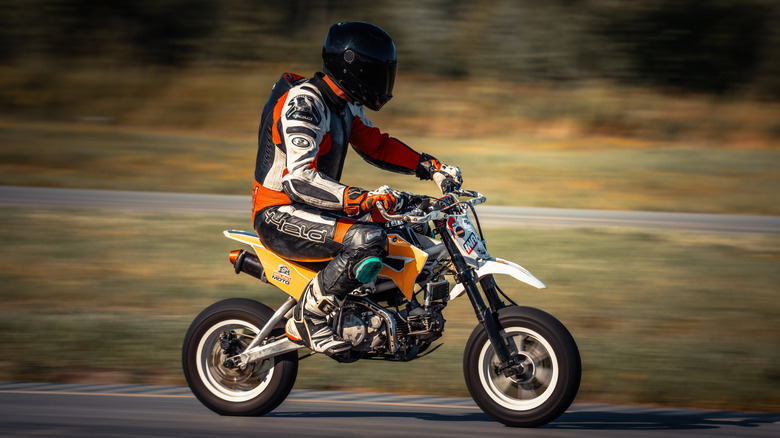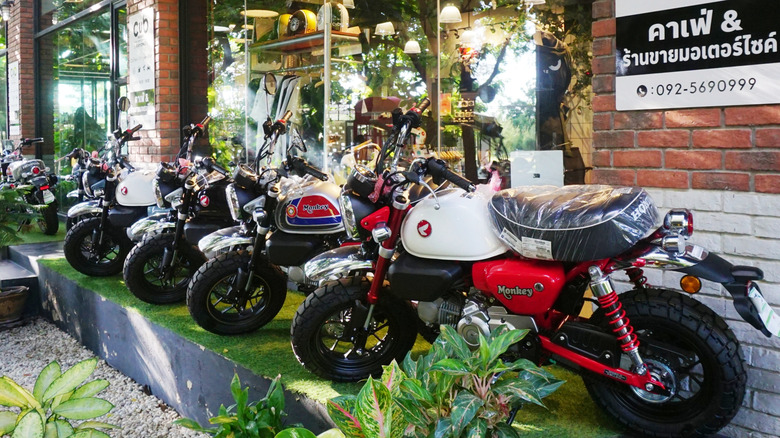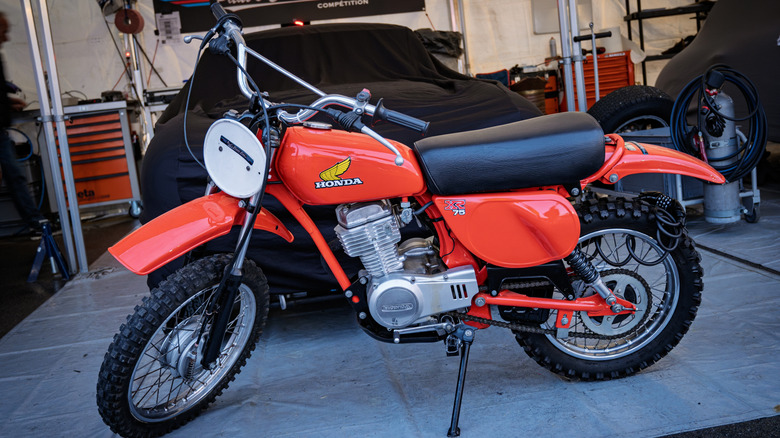Mini Bike Vs. Pit Bike: What's The Difference?
When it comes to motorcycles, choice is usually the name of the game. If you are looking for blinding speed, Kawasaki's Ninja line and Honda's CBR series will make sure you speed down a racetrack in record numbers. Now, if you want something slow but powerful, a motorcycle that can conquer any trail, Rokon's bikes will ensure you explore the rugged outdoors without any hitch. For something more niche, why not try a mini or pit bike? These motorcycles differ mainly in their use, which ultimately dictates the types of features each comes with.
Both mini and pit bikes are usually small — comically so — especially when you park them next to some of the biggest cruisers ever made, like the Boss Hoss V8. However, what they lack in size, they more than make up for in adventurous fun. While both are pocket bikes best for small-bodied riders such as kids and teens, the main difference between the two is that mini bikes are perfect for everyday riding, while pit bikes are more geared toward competitive riding. In that respect, both bikes come with aspects that allow them to shine in their respective niches, such as their engine size, power output, and suspension types.
Pit bikes are more aggressive than mini bikes
Mini bikes come with easier-to-handle, less powerful engines that deliver steady yet balanced power. Given their approach to everyday use, the engines are durable and don't consume much fuel. They are also easier to maintain, which, when coupled with low-powered engines, makes them the perfect bikes for beginners, such as children starting on their first bikes.
On the other hand, pit bikes are more geared toward professionals who are accustomed to the track. As such, they come with more powerful engines, usually between 50cc and 150cc, that offer a punchier power delivery. As you may expect, these engines require the same special care and attention that most racetrack machinery requires, making them comparatively more challenging to maintain.
Engines aside, these bikes are built in distinct styles. Of course, pit bikes are more aggressive in their build, promoting that forward-leaning stance that many track motorcycles, such as the blindingly fast Ninja H2R, are known for. As with other track-focused motorcycles, riding pit bikes for extended periods of time might lead to fatigue due to the riding stance, especially for riders who aren't used to such motorcycles. Conversely, mini bikes are more relaxed in their build, allowing for more comfortable rides that won't make you feel like someone took a hammer to your back.
Mini bikes are relatively cheaper to acquire and maintain
The type of bike you settle for will essentially boil down to the intended use and the accompanying features. While mini bikes, like the TrailMaster Hurricane 200X, might seem to offer less than pit bikes, especially when you look at power output and aspects such as their suspension, consider that they may be cheaper to acquire, maintain, and repair. They also offer the perfect starting point for younger riders who have little to no experience.
Additionally, they are great everyday bikes that can shine both on and off roads. As for pit bikes, such as the Kawasaki KLX 110R, their small, compact size makes them a blast to ride. Although they might be more expensive to acquire and require specialized care to ensure they run at their best, you can never overlook the amount of power they bring to the track.
Given the type of roads these two bikes usually frequent, aspects like their suspensions are also tweaked to help them perform even better. For pit bikes, you may find suspensions that are more familiar to racetracks, like performance-oriented, stiff upside-down forks. As for mini bikes, the suspensions will be more geared for all-around use, with a focus on providing an overall smoother riding experience. Some entry-level mini bikes, like the FRP GMB100, won't feature built-in suspension, so it all depends on what the biker wants. Ultimately, everything comes down to your personal preference.


